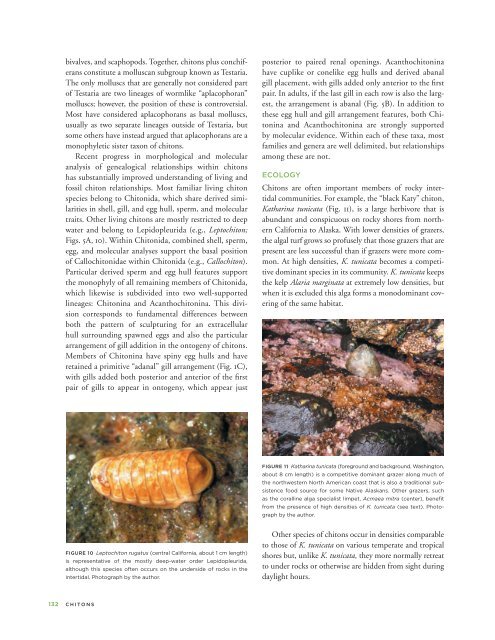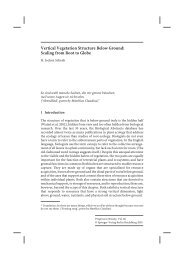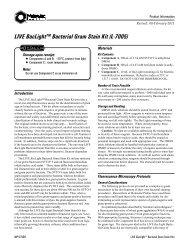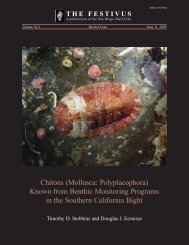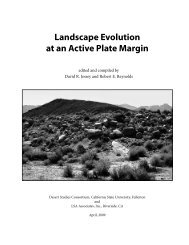CHITONS - Biological Science - California State University, Fullerton
CHITONS - Biological Science - California State University, Fullerton
CHITONS - Biological Science - California State University, Fullerton
Create successful ePaper yourself
Turn your PDF publications into a flip-book with our unique Google optimized e-Paper software.
ivalves, and scaphopods. Together, chitons plus conchiferans<br />
constitute a molluscan subgroup known as Testaria.<br />
The only molluscs that are generally not considered part<br />
of Testaria are two lineages of wormlike “aplacophoran”<br />
molluscs; however, the position of these is controversial.<br />
Most have considered aplacophorans as basal molluscs,<br />
usually as two separate lineages outside of Testaria, but<br />
some others have instead argued that aplacophorans are a<br />
monophyletic sister taxon of chitons.<br />
Recent progress in morphological and molecular<br />
analysis of genealogical relationships within chitons<br />
has substantially improved understanding of living and<br />
fossil chiton relationships. Most familiar living chiton<br />
species belong to Chitonida, which share derived similarities<br />
in shell, gill, and egg hull, sperm, and molecular<br />
traits. Other living chitons are mostly restricted to deep<br />
water and belong to Lepidopleurida (e.g., Leptochiton;<br />
Figs. 5A, 10). Within Chitonida, combined shell, sperm,<br />
egg, and molecular analyses support the basal position<br />
of Callochitonidae within Chitonida (e.g., Callochiton).<br />
Particular derived sperm and egg hull features support<br />
the monophyly of all remaining members of Chitonida,<br />
which likewise is subdivided into two well-supported<br />
lineages: Chitonina and Acanthochitonina. This division<br />
corresponds to fundamental differences between<br />
both the pattern of sculpturing for an extracellular<br />
hull surrounding spawned eggs and also the particular<br />
arrangement of gill addition in the ontogeny of chitons.<br />
Members of Chitonina have spiny egg hulls and have<br />
retained a primitive “adanal” gill arrangement (Fig. 1C),<br />
with gills added both posterior and anterior of the fi rst<br />
pair of gills to appear in ontogeny, which appear just<br />
FIGURE 10 Leptochiton rugatus (central <strong>California</strong>, about 1 cm length)<br />
is representative of the mostly deep-water order Lepidopleurida,<br />
although this species often occurs on the underside of rocks in the<br />
intertidal. Photograph by the author.<br />
132 <strong>CHITONS</strong><br />
posterior to paired renal openings. Acanthochitonina<br />
have cuplike or conelike egg hulls and derived abanal<br />
gill placement, with gills added only anterior to the fi rst<br />
pair. In adults, if the last gill in each row is also the largest,<br />
the arrangement is abanal (Fig. 5B). In addition to<br />
these egg hull and gill arrangement features, both Chitonina<br />
and Acanthochitonina are strongly supported<br />
by molecular evidence. Within each of these taxa, most<br />
families and genera are well delimited, but relationships<br />
among these are not.<br />
ECOLOGY<br />
Chitons are often important members of rocky intertidal<br />
communities. For example, the “black Katy” chiton,<br />
Katharina tunicata (Fig. 11), is a large herbivore that is<br />
abundant and conspicuous on rocky shores from northern<br />
<strong>California</strong> to Alaska. With lower densities of grazers,<br />
the algal turf grows so profusely that those grazers that are<br />
present are less successful than if grazers were more common.<br />
At high densities, K. tunicata becomes a competitive<br />
dominant species in its community. K. tunicata keeps<br />
the kelp Alaria marginata at extremely low densities, but<br />
when it is excluded this alga forms a monodominant covering<br />
of the same habitat.<br />
FIGURE 11 Katharina tunicata (foreground and background, Washington,<br />
about 8 cm length) is a competitive dominant grazer along much of<br />
the northwestern North American coast that is also a traditional subsistence<br />
food source for some Native Alaskans. Other grazers, such<br />
as the coralline alga specialist limpet, Acmaea mitra (center), benefi t<br />
from the presence of high densities of K. tunicata (see text). Photograph<br />
by the author.<br />
Other species of chitons occur in densities comparable<br />
to those of K. tunicata on various temperate and tropical<br />
shores but, unlike K. tunicata, they more normally retreat<br />
to under rocks or otherwise are hidden from sight during<br />
daylight hours.


